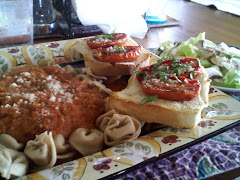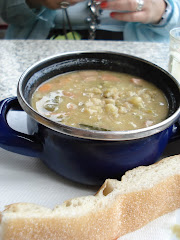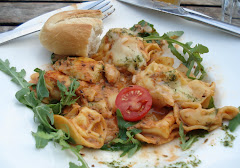If you've been reading my blog, you know that not only do I want to stay heart healthy, I also want to lose weight. Even though I've been a vegetarian/vegan now for several months, I haven't seen much in the weight loss department...oh sure a few pounds here and there, but no moment when I step on the scale and yell from the top of my lungs...."I'M SKINNY!!! I DID IT!", you know, that eureka moment! Its not that I have tons of weight to lose, just a measly 10 lbs!
So, I've decided to take my "veganism" one step further....macrobiotics....sounds like science fiction doesn't it?
I first got interested in this way of eating (its NOT A DIET!) with the Alica Silverstone book "The Kind Diet". So I thought I'd give it a try. She has some really interesting recipes of which I will blog about in the future.
So, what exactly IS a macrobiotic diet. The word macrobiotic means "long life". Okay, I like that...I want to stay healthy and live a long life. The philosophy was developed by a Japanese educator named George Ohsawa, who thought simplicity was the key to optimal health. Unfortunately, his simplistic diet meant after you gave up everything, you eventually only eat brown rice and water. Not a good idea!
So, along came Michio Kushi who liked Ohsawa's macrobiotic idea and decided to open in 1978 the Kushi Institute in Boston. With his wife Aveline (I knew a woman would be involved!), Kushi published many books on macrobiotics ansd was responsible for making macrobiotics popular in North America.
Now we know who started it, but what exactly IS it?
1. Whole grains. 50-60% of your meal should be whole grains. Go crazy! There are a ton of whole grains...(before I started all this, I thought whole grains would only be in bread and pasta) Whole grains include, brown rice, whole wheat berries, barley, millet, rye, corn, buckwheat just to name a few. Even though rolled oats, noodles, pasta, bread, baked goods and other flour products that have whole grains in them are good, they are only eaten occasionally.
2. Soup. One to two cups or bowls of soup per day, especially miso and shoyu, which are made from fermented soybeans are commonly used. Shoyu, I never even heard of Shoyu before and I love to cook! Shoyu is a naturally brewed soy sauce made from soybeans and wheat. Shoyu is the Japanese name for soy sauce.
3. Vegetables. 25 to 30% of your daily intake. One third of your vegetables should be raw, the rest can be steamed, boiled, baked or sauteed.
4. Beans. 10% of your daily intake. This not only includes any kind of bean, but also bean products such as tofu and tempeh.
5. Seeds and nuts in moderation.
6. Fruit. Local is best, and can be consumed several times a week. Tropical fruits such as mango, pineapple and papaya is usually avoided.
7. Desserts! Yes in moderation. 2-3 times per week. Pick desserts that are naturally sweet such as apples, squash, adzuki beans and dried fruit. Natural sweeteners such as rice syrup (my favorite) barley malt can be used. Sugar, honey, molasses, chocolate, carob and other sweeteners are avoided. (okay, never have chocolate again....very doubtful!)
8. Condiments and seasoning include, natural sea salt, shoyu,. brown rice vinegar, umeboshi vinegar, umeboshi plums, grated ginger rott, fermented pickles, gomashio (roasted sesamae seeds), roasted seaweed and sliced scallions.
9. Cooking oil is typically unrefined vegetable oil. One of the most common oils used is dark sesame oil. Other oils that can be used are light sesame oil, corn oil, and mustard seed oil. (I'm still sticking with safflower oil).
Okay....10 is Animal Products....yes macrobiotics eat a samll amount of fish or seafood several times per week. BUT, meat, poultry, eggs and dairy are usually avoided.
If you eat fish, make sure you add horeseradish, wasabi, ginger, mustard or grated daikon to help the body detoxity from the effects of the fish and seafood.
Two great books if your interested, Mihio Kushi "the Macrobiotic Way" (consider this your "bible" to macrobiotic's)
and a really fun interestering book, Jessica Porter "the Hip Chick's guide to Macrobiotics" (don't you just love that title?)
So this is MACROBIOTICS. I'm not going to follow it strictly that's for sure But I'm going to try. At least several times a week. Do what's right for you. I'm not finished educating you about Macrobiotics, as I learn, I will share.
Eating healthy is a learning process, you can learn something every day.....I promise I will share my new found knowledge and together we can make our hearts happy and our minds healthy!
Subscribe to:
Post Comments (Atom)

.jpg)



.jpg)
.jpg)

.jpg)
.jpg)

No comments:
Post a Comment